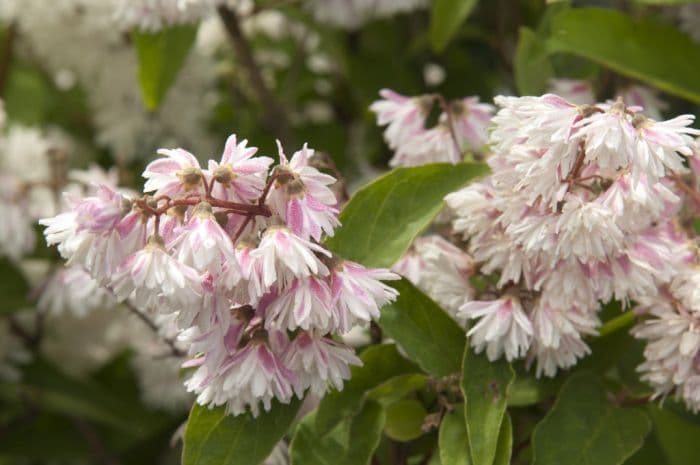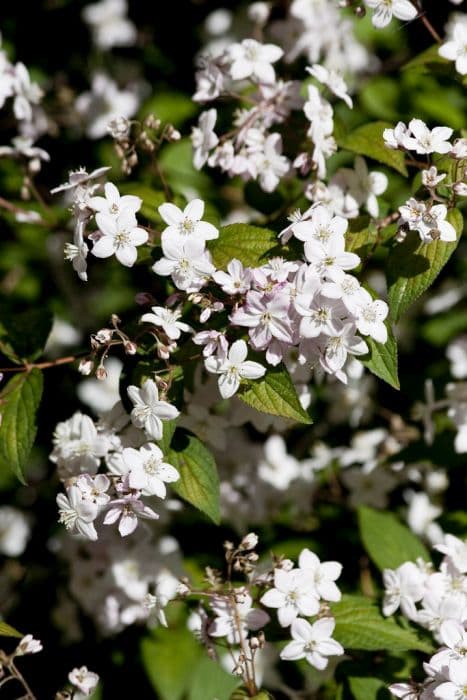Fuzzy Deutzia Deutzia scabra 'Codsall Pink'

ABOUT
Codsall Pink is a charming plant recognized for its flurry of delicate, clustered flowers that possess a gentle pink hue, shifting towards white at their centers. The flowers are notable for their star-like shape, each petal being slender and slightly wrinkled to touch, which gives the plant its common name attribution of 'Codsall Pink'. These blossom in ample clusters, creating a soft, frothy effect amidst the foliage during its peak flowering season. The leaves of the Codsall Pink provide a complementary backdrop to its floral display, with a rough, textured surface that feels somewhat sandpapery, thus its specific epithet. The leaves are oval-shaped with a pointed tip and serrated edges, and they exhibit a rich green color that may acquire a purplish tinge in autumn, adding to the plant's seasonal interest. This deciduous shrub features gracefully arching branches that help display the flowers in a cascading manner. Overall, the appearance of Codsall Pink is characterized by its romantic flower clusters and pleasing foliage that together create an aesthetic suitable for various garden settings, claiming a spot in the hearts of plant enthusiasts who appreciate its modest yet attractive demeanor.
About this plant
 Names
NamesFamily
Hydrangeaceae
Synonyms
Fuzzy Deutzia, Pride of Rochester, Rough Deutzia
Common names
Deutzia scabra 'Codsall Pink'.
 Toxicity
ToxicityTo humans
Deutzia 'Codsall Pink' is not typically known for being toxic to humans. It does not contain significant toxins known to cause harm if touched or ingested. However, as with any plant material, individuals may have varying sensitivities, and ingestion could potentially lead to an upset stomach or other digestive discomfort due to the plant not being part of a normal human diet.
To pets
Deutzia 'Codsall Pink' is not commonly listed as a toxic plant to pets either. It is not known to contain substances that are harmful to dogs, cats, or other household animals. Nevertheless, ingestion of plant material can sometimes result in gastrointestinal upset for pets, so it is advisable to prevent pets from eating this or any ornamental plants.
 Characteristics
CharacteristicsLife cycle
Perennials
Foliage type
Deciduous
Color of leaves
Green
Flower color
Pink
Height
6-10 feet (1.8-3 meters)
Spread
4-8 feet (1.2-2.4 meters)
Plant type
Shrub
Hardiness zones
5-8
Native area
Japan
Benefits
 General Benefits
General Benefits- Ornamental Appeal: Deutzia scabra 'Codsall Pink', commonly known as Fuzzy Deutzia, offers ornamental value with its pink flowers that bloom in late spring to early summer, adding color and visual interest to gardens.
- Attracts Pollinators: The plant's flowers attract bees, butterflies, and other pollinators, which are beneficial for garden biodiversity and the pollination of nearby plants.
- Easy to Grow: Fuzzy Deutzia is known for being low-maintenance and easy to care for, making it a good choice for gardeners of all skill levels.
- Hardiness: It is generally hardy in a range of climates and can withstand cold temperatures, which makes it suitable for many temperate gardens.
- Deciduous Shrub: As a deciduous shrub, it adds seasonal dynamics to landscapes, with foliage changing color in the fall before shedding its leaves.
- Versatility in Landscaping: Can be used for various landscaping purposes including as a specimen plant, in borders, or as part of a flowering hedge.
- Durable: Fuzzy Deutzia is known for having good resistance to pests and diseases, which reduces the need for chemical treatments.
 Medical Properties
Medical Properties- This plant is not used for medical purposes.
 Air-purifying Qualities
Air-purifying QualitiesThis plant is not specifically known for air purifying qualities.
 Other Uses
Other Uses- Art and Craft Material: The textured bark of Deutzia can be used in art projects for creating natural textures or as a component in handmade paper.
- Photography Subject: With its 'Codsall Pink' blossoms, the Deutzia offers photographers a beautiful subject to capture in garden and macro photography.
- Educational Tool: Educators can use the growing cycle of Deutzia in lessons about plant biology, demonstrating the stages from bud to flower.
- Garden Themed Decor: Dried branches and flowers can be incorporated into decorations and wreaths for a natural, garden-inspired look.
- Culinary Garnish: While not widespread, the flowers can sometimes be used as an edible garnish in haute cuisine, provided they haven't been treated with pesticides.
- Floral Arrangements: The flowers can be cut and used in bouquets or arrangements for their delicate appearance and soft pink hue.
- Wildlife Garden: Deutzia can be included in wildlife gardens to attract pollinators such as bees and butterflies with its flowers.
- Stress Relief: Spending time pruning and caring for Deutzia plants can offer a form of mindfulness and stress relief through gardening.
- Landscape Photography: The plant can be used to enhance garden landscapes, offering a pink-flushed backdrop for wide-angle photography.
- Bonsai Specimen: Though not common, the Deutzia's branching pattern and flowers can make it an interesting candidate for bonsai cultivation.
Interesting Facts
 Feng Shui
Feng ShuiThe Deutzia is not used in Feng Shui practice.
 Zodiac Sign Compitability
Zodiac Sign CompitabilityThe Deutzia is not used in astrology practice.
 Plant Symbolism
Plant Symbolism- Purity: Deutzia scabra 'Codsall Pink' has delicate pink flowers which are often associated with innocence and purity.
- Humility: This plant, also known simply as Deutzia, has a humble, unassuming growth habit, reflecting the virtue of modesty.
- Transient Beauty: The short-lived blooms of the Deutzia symbolize the fleeting nature of beauty in life.
 Water
WaterFuzzy Deutzia requires regular watering, especially during dry spells, to maintain evenly moist soil. Aim to water deeply rather than frequently, which encourages the roots to grow downward in search of moisture. Generally, providing about an inch of water once a week is sufficient, but this may vary depending on weather conditions and soil type. During hot or windy weather, you might need to water twice a week. Always check the top couple of inches of soil for dryness before watering; if it's dry to the touch, it's time to water. Over-watering can be just as harmful as under-watering, so it’s important to monitor soil moisture levels regularly.
 Light
LightFuzzy Deutzia thrives in full sun to partial shade. The ideal location for this plant is a spot where it receives at least four to six hours of sunlight daily. Some afternoon shade can be beneficial in hotter climates to prevent leaf scorch. When planting in partial shade, ensure that the plant still gets bright, indirect light for most of the day.
 Temperature
TemperatureFuzzy Deutzia prefers temperate climates and can survive in temperatures ranging from just below freezing to about 85 degrees Fahrenheit. Ideal growth occurs when the temperature is between 60 and 75 degrees Fahrenheit. It is hardy in USDA zones 5 through 8, which means it can withstand winter low temperatures down to -20 degrees Fahrenheit. Always protect your plant from extreme temperature fluctuations, whether it's unusually hot summers or cold snaps.
 Pruning
PruningPrune Fuzzy Deutzia to remove dead or damaged wood and to shape the plant or maintain size. Pruning should occur after flowering, usually in late spring or early summer, to ensure bud set for the next year. Periodically thin out older branches to encourage new growth and improve air circulation, which helps prevent disease. Disinfect your pruning tools between cuts to prevent the spread of disease.
 Cleaning
CleaningAs needed
 Soil
SoilFuzzy Deutzia thrives in well-draining loamy soil enriched with organic matter; aim for a soil pH between 6.0 and 7.0 for optimal growth.
 Repotting
RepottingFuzzy Deutzia rarely needs repotting; it's usually grown in-ground and not as a container plant, so repotting is not a common practice.
 Humidity & Misting
Humidity & MistingFuzzy Deutzia is tolerant to a range of humidity levels and does well in average outdoor conditions with no specific humidity requirements.
 Suitable locations
Suitable locationsIndoor
Provide bright light, well-draining soil, and moderate water.
Outdoor
Plant in sun to part shade, in well-drained soil, with mulch.
Hardiness zone
5-8 USDA
 Life cycle
Life cycleThe life cycle of Deutzia scabra 'Codsall Pink', commonly known as the Fuzzy Pride of Rochester, begins with seed germination, which occurs in favorable environmental conditions of warmth and moisture. After germination, the seedling emerges and starts to develop a root system and foliage, progressing into the vegetative stage with vigorous growth of stems and leaves. As the plant matures, it enters a pre-floral stage, during which buds form in response to specific cues such as day length and temperature. The floral stage follows, with the plant producing clusters of pinkish flowers typically in the late spring to early summer, attracting pollinators for sexual reproduction. Following pollination and fertilization, the plant develops fruits that bear seeds, completing its reproductive cycle. Finally, as a perennial shrub, Fuzzy Pride of Rochester enters a period of dormancy during colder months, conserving energy to repeat its growth cycle the following spring.
 Propogation
PropogationPropogation time
Spring-Early Summer
Deutzia scabra 'Codsall Pink', commonly known as Fuzzy Deutzia, is most effectively propagated by taking softwood cuttings in late spring or early summer. To do this, gardeners should select healthy, non-flowering shoots and cut a piece about 4 to 6 inches (about 10 to 15 centimeters) in length. The lower leaves should be removed, and the cut end can be dipped in rooting hormone to encourage root development. Then, the cutting should be planted in a well-draining soil mix, ideally in a pot that allows for plenty of room for root growth. It's important to keep the soil moist but not overly wet, to provide high humidity around the plant, often using a plastic cover or a propagator. Roots typically develop within a few weeks, after which the cuttings can eventually be transplanted to their permanent location.








![Hydrangea [Pink Annabelle] ('Ncha1')](/_next/image?url=https%3A%2F%2Fplants-admin.emdemapps.com%2Fimages%2Fplants%2F%2Fimages%2F604b576c63619.png&w=640&q=75)
